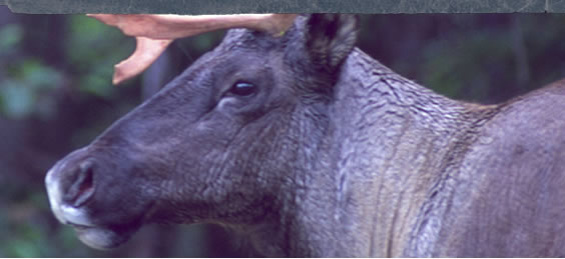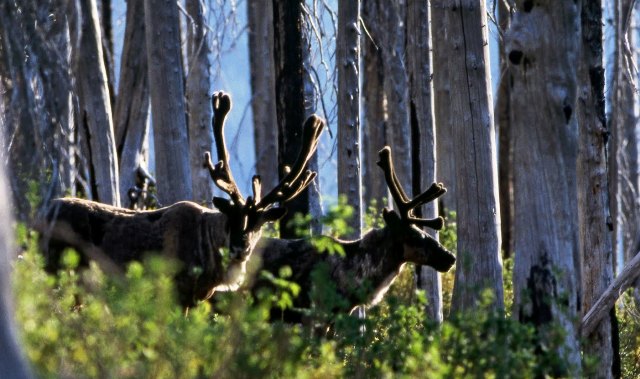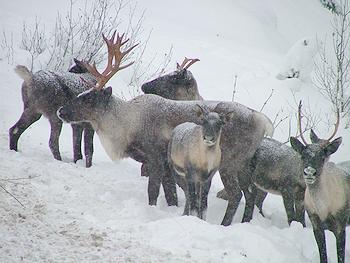ignored

ecology

myvalleysun.com
New Ideas About Life and Living in the Okanagan

New Ideas About Life and Living in the Okanagan
We update this website on a regular basis.

caribou
revisited
mountain
BC Parks insists that there is a dwindling herd of Mountain Caribou in and around Monashee Provincial Park. Yet the Ministry of Forests allows more logging of Caribou habitat because they say that there are none left. Then BC Parks and our local Area Planning Commissions give the green light for more Helisking in Caribou range, and now there is an application to create mountain bike trails
in this same range.
Are we so disconnected from our landscape that we can ignore another species that is at risk?
This disconnect has been going
for eight years and is being ignored.
By everyone.
And it may continue until
the very last caribou is gone.
Don Elzer revisits a feature he wrote in 2006 and discovers that little has changed.
According to the provincial
government the
Mountain Caribou
population were estimated at 10 in 1994 and seven in 2006. The minister in charge at the time, Pat Bell and his colleagues decided that the Monashee population, along with two others of the eight in the province, were not worthy of being included in the Caribou Recovery Plan.
In 2007, it was the end of the line for the Monashee herd; they were to be considered extinct – at least by way of government policy.
Yet today, were told that caribou habitat is being protected – and we’re also being told that more logging and heliskiing can occur because there’s no more caribou.
The disconnect is astonishing – are there caribou or not?
In 2006, I had written a feature about this very subject and now eight years later the events, the warnings and the politics have not changed – the caribou are still on their own waiting for us to take notice.
Monashee Provincial Park north of Cherryville protects substantial stands of old growth cedar, spruce and hemlock. Lush green forests grace the valley bottoms and, in the spring, alpine meadows blossom with a colourful array of wildflowers. The park is also known for some of the oldest rock formations in western Canada. Peters and Margie Lakes sparkle beneath 2697 metre high Mount Fosthall, the highest peak in the park and part of the rugged Monashee Range of snow-capped peaks that surround the park.
According to BC Parks, “Lucky visitors may get a glimpse of the rare mountain caribou or wolverine or the much more common mule deer, ground squirrels and pikas. This undeveloped mountain wilderness is a wonderful adventure for both experienced backcountry hikers and willing beginners alike”.
However this wilderness is it risk, the stage has been set for the mountain caribou to be gone forever in this area of the Monashee.
The mountain caribou, a sub-strain of the woodland caribou which only a few generations ago stretched from the southern Monashee and across the Okanagan Highlands are about to become extinct from this area, and other endangered species such as the wolverine and grizzly bear may be placed at risk in the process.
Found in the eastern parts of B.C. and down into Idaho (where they are protected under the U.S. Endangered Species Act), mountain caribou are one of the most endangered mammals in North America.
While there were an estimated 2,500 animals in B.C. in the 1990s, today there are fewer than 1,900. To make matters worse, what historically had likely been one large population has been fragmented into as many as 18 subpopulations, some of which are completely isolated from one another. Such isolation raises problems of inbreeding and makes populations less likely to survive. In the vicinity of Monashee Provincial Park there remains only eight mountain caribou remaining in the herd.
The BC government has recently previewed a plan for mountain caribou recovery in British Columbia. According to the Minister of Agriculture and Lands, Pat Bell, the BC government’s recipe for caribou conservation is to kill cougars, wolves and bears, and abandon smaller herds.
The minister is recommending that we give up on the remaining eight caribou left in the Monashee herd and move them to a larger herd located in northern B.C.
While he indicated that government wants to kill predators to protect caribou and move animals from smaller herds into larger herds, effectively further shrinking caribou range, he gave no indication that the government would address the real reason for caribou declines: habitat destruction.
It appears as though the government intends to allow continued logging and motorized recreation in habitat critical for caribou and other at-risk species, such as wolverine, grizzly, and lynx.
The science directing the move is a questionable one since the Monashee herd in the past few years is one of the few herds that is actually growing in numbers according to some sources.
B.C.'s Forest Practices Board issued a report in September 2004 that called for quick action to protect the threatened mountain caribou. It open for debate as to whether a two-year dwell time is considered quick action by government.
Perhaps the question we need to ask, is whether corporate timber licences and corporate tourism tenure within that time frame received more or less attention than the plight of the Caribou?
If we allow a strategy whereby it’s acceptable to bring about the extinction of a species in a region by moving the survivors to a larger herd, are we not creating an incentive for failure that might be encouraged by some commercial users of the land-base?
There is little discussion about the possibility of transporting caribou from a larger healthy herd to the south Monashee to grow the herd.
Due to its remoteness, this region of the Monashee remains unwatched by communities and conservation groups, and at the end of the day, How does the public actually check the analysis and the decisions from government?
Scientists have found that habitat destruction is the primary reason for caribou declines. Mountain caribou are found only in BC and small parts of three US states, and rely on intact tracts of old-growth forests free from intensive industrial and recreation activities for survival.
The rainforests of the Monashee have been under siege for decades now. The Upper Shuswap area represents a gateway for timber interests, snow cat skiing and heliskiing.
Killing predators before we protect habitat is not the answer. A mere 25% of caribou habitat is inside protected areas, while a full 33% has absolutely no protection whatsoever. Logging and motorized recreation are still allowed in a vast majority of caribou habitat.
The South Selkirk herd grew by 30% in response to habitat protection, closures to motorized recreation access, the transplants of animals from healthier herds and the surgical removal of a single cougar known to be preying on caribou, has demonstrated that caribou recovery is a realistic objective.
The idea of bringing about the extinction of a species would certainly irritate the sustainability goals that Premier Gordon Campbell has actively supported. This issue could strike a division within the liberals in Victoria: those actively growing the number of backcountry tourism resorts, and streamlined industrial access to crown land; against those who can see the voter fury grow the more the word “extinction” appears in the press.
One cabinet minister from the Kootenay region has lobbied on behalf of snowmobilers in his riding, even if their activities imperil the caribou.
"I am prepared to state my position publicly that this herd is doomed and should either be moved or written off," Bill Bennett, minister of state for mining, said in an earlier e-mail when he sat as a backbencher in the Liberal government.
"Government should not be throwing good money after bad," he said.
So it appears the government is compromising, accepting “some” extinction being ok? The caribou is a Canadian icon and the very symbol of wilderness, and deserves the best science-based recovery plan we can create, not the personal political solutions of the MLA responsible, nor the short-term aspirations of economic targets.
Scientists agree that habitat alteration is the leading cause of mountain caribou declines. However the BC government has done little to reverse the habitat loss, and continues to authorize logging across nearly 60,000 hectares of mountain caribou habitat. Conservation groups have repeatedly asked for a moratorium on logging in caribou habitat until a provincial recovery plan is completed and implemented. But the government has responded only by asking the timber industry for voluntary logging deferrals, with very mixed results.
A recent comment from Dr. David Suzuki also questioned the governments actions, “We know that logging is still allowed in mountain caribou habitat. We don’t know how much illegal hunting is occurring because we don’t have enough conservation officers or a comprehensive system to monitor poaching. And some of the creatures the government has suggested we kill to protect the caribou, such as grizzly bears and wolverines, are themselves threatened species.”
Habitat protection won’t save all the caribou, but at the end of the day it will save some, and the process will make us a better stewards. What we do in our own backyard as a community sends a powerful message to future generations about the kind of world we wanted to leave behind. We can do something about saving the mountain caribou and the old-growth forests in the Monashee, and its time we all did.
(30)
Superbly adapted for snow and cold with their large hooves and insulating coat, caribou would have been among the first animals to return to this part of the world at the end of the last Ice Age, around 9,000 years ago. Their numbers declined here after the completion of the Canadian Pacific Railway made hunting them for market possible. Conservation measures introduced in the 1930s placed limits on caribou hunting, but their numbers never fully recovered. Hunting caribou in the Columbia region ceased entirely in 1996.
Since the 1970s, hydro-electric reservoirs and logging have reduced low elevation old growth forest habitat. The scattered remaining bits of habitat take more energy for caribou to access and traveling exposes them to more hazards. Accidents with avalanches and terrain features where the leading cases of mortality among radio-collared caribou in a seven year study in the 1990s.
The past decade has also seen a rapid expansion of snowmobiling and helicopter skiing in the subalpine zone, increasing the disturbance in caribou’s late winter habitat. Research results from radio-collared caribou indicate that accidents, particularly avalanches, are the main cause of mortality.
In an effort to manage resources on an ecosystem basis, Parks Canada has participated in caribou research and monitoring projects with provincial agencies since 1992.
Caribou are unique in the deer family in that both females and males grow antlers. Mountain caribou are larger than deer and smaller than elk, with males weighing approximately 175 kg. Their hollow fur insulates them through the long mountain winters.
When snow falls in early winter, mountain caribou are found in low elevation old-growth cedar and hemlock forests where trees may exceed 1000 years in age. Here, they feed on ground plants such as falsebox. Once the mid-winter snow buries those foods, caribou move higher into sub-alpine spruce/fir forests where their dinner-plate-sized feet act like snowshoes, allowing them to use the deep winter snow as a platform to reach lichens draped from old-growth trees. These tree lichens are typically the only food source for caribou form most of the winter, and are found in abundance only in old-growth forests.
The critical winter range of mountain caribou overlaps considerably with backcountry recreation activities such as helicopter skiing, snow-cat skiing, and snowmobiling. Technological advances and unregulated access has led to more and more people spending their winter play time in endangered mountain caribou habitat. Commercial recreation enterprises have unprecedented access to BC’s wilderness. This adds additional stress to an animal that is already being squeezed by habitat fragmentation, at a time of the year when it is most vulnerable because of the increased energy demands of winter.
BC’s back-country recreation industries are not required to meet with clear, enforceable standards, the BC government has relied on voluntary “best management practices” to reduce impacts to caribou. Additionally, the BC government continues to grant helicopter ski tenures, as recently as December 2005, in critical winter mountain caribou habitat, despite protests from independent and government biologists.
Scientists agree that climate change is already affecting British Columbia's ecosystems, and we can expect such change to continue. It is harder to predict the exact nature of those changes, and how they will affect us. Most scientists believe temperatures will continue to rise. Winter snow-packs in the inland temperate rainforest are already decreasing, and this decrease will probably continue. This is a potential problem for caribou, which rely on deep snow to be able to reach lichen, their main winter food.
We know that healthy forests, such as old-growth, are better able to withstand and adapt to change. Because logging releases the carbon that is contained in forests, the Union of Concerned Scientists recommends forest conservation as its top forest-based strategy for mitigating global warming. (Union of Concerned Scientists)
All animals need healthy habitats that allow them to move across the landscape when they need to. Caribou have weathered a number of climate change events over the last several thousand years. If enough forests are protected, and habitat remains connected, the outlook for caribou – and many other species including humans – will be much brighter.
The Mountain Caribou are the same subspecies as woodland caribou once found throughout boreal Canada, the mountain caribou’s different use of habitat makes it an ecotype unique to the mountains of the interior wet belt of south-eastern British Columbia.
Mountain caribou make up the southernmost occurrence of caribou in the world. Other kinds of caribou include the barren-ground caribou of Canada's far north, and several kinds of reindeer in Europe and Asia.
Who is Logging Mountain Caribou Habitat?
Written by Don Elzer in 2006
Logging continues to have severe impact on the Mountain Caribou. Habitat alteration disrupts the conditions under which mountain caribou, and other species including predators, have co-evolved.
Clear-cuts attract deer, elk and moose, because for a few years after logging there is more food for them (low shrubs and herbs). This allows these animals – and their predators – to increase and expand into mountain caribou habitat.
Historically, it was not energy efficient for predators to rely on caribou as a main food source, since caribou spread themselves throughout the forest at relatively low densities. But as the ranges of deer and moose increase, predators are encountering – and killing -- caribou more frequently.
Ironically, the taxpayer-owned BC Timber Sales program (BCTS) is one of the top three loggers of remaining mountain caribou habitat. The largest logger of mountain caribou habitat is West Fraser Timber followed by Tolko Industries.
West Fraser Timber Co. Ltd
19,274 ha (33,553 ha)
Tolko Industries Ltd.  6,810 ha
6,810 ha
BC Timber Sales  6,762 ha
6,762 ha
Federated Cooperatives Ltd.  3,958 ha
3,958 ha
Louisiana Pacific Ltd.  2,971 ha
2,971 ha
Pope & Talbot Ltd.  2,168 ha
2,168 ha
Springer Creek Forest Products Ltd.  1,762 ha
1,762 ha
*The above table is from Staring At Extinction published in May 2005. More recent analysis (December 2005) showed West Fraser to have 33,553 ha of planned cut-blocks in mountain caribou range. Tembec Inc. is theoretically 5th in area with 2,775 ha of cut-blocks approved, but the company has agreed to moratoria on all cut-blocks within mountain caribou habitat except where mountain pine beetle infestation is extensive, and to not build roads anywhere in mountain caribou habitat.
Recent large-scale outbreaks of mountain pine and spruce bark beetles in many areas of BC have prompted aggressive logging activities. in many forest stands, including critical mountain caribou habitat, the war against beetles involves use of clear-cut, selection, and salvage logging, as well as the construction of new roads. This puts added pressure on mountain caribou: lichen-bearing trees are lost, other ungulates ad their predators are drawn to new cut-blocks and roads, and increased access is created for backcountry recreationists.
The few legislated measures that are in place to protect caribou habitat still allow entry into undeveloped areas when beetles are deemed to be a problem. Giving these activities priority within caribou habitat must stop. After all, standing dead and fallen trees provide essential lichen food sources for caribou. A healthy forest requires dead trees, and healthy forested landscapes periodically contain entire stands of dead trees.
Learn more about this issue on-line:
The Mountain Caribou Project
Columbia Mountains Institute
of Applied Ecology
The David Suzuki Foundation
caribou in crises
The Mountain Caribou:
An Examination of a Species at Risk in the Monashee
Written by Don Elzer in 2006
